Table of Contents
The Heights Connect With Ft. Lee
The George Washington Bridge, a majestic and iconic structure connecting Manhattan, New York City, to Fort Lee, New Jersey, stands as a testament to human engineering and ambition. Spanning the Hudson River, this remarkable suspension bridge has a rich history that dates back to the early 20th century. Over the years, it has not only served as a vital transportation link but also as a symbol of unity and progress. In this article, we delve into the fascinating history of the George Washington Bridge, highlighting its key milestones and its vibrant illumination that captivates viewers during special occasions.
A Vision Takes Shape
The idea for the George Washington Bridge began to take shape in the early 20th century as the need for a new river crossing became evident. At that time, the only available crossings were the congested ferries or the narrow, aging structures like the nearby High Bridge. It was clear that a more substantial and efficient solution was required to meet the growing demands of a rapidly expanding city. The initial concept for the bridge can be credited to Cass Gilbert, an accomplished architect who proposed a cantilever bridge design. However, this idea was met with skepticism from engineers, who favored suspension bridges for such a significant undertaking. Ultimately, the suspension bridge design, championed by engineer Othmar Ammann, was chosen for its durability and aesthetic appeal.

Construction Challenges
Construction of the George Washington Bridge was a monumental task that began in October 1927. The bridge’s location, spanning the treacherous waters of the Hudson River, presented numerous challenges. Engineers had to contend with strong currents, variable weather conditions, and the need to maintain navigation channels for ships. Despite these difficulties, the project moved forward, showcasing the engineering prowess of the era.
One of the most impressive aspects of the bridge’s construction was the simultaneous work on the New York and New Jersey sides, with each team working towards the center span. This innovative approach helped expedite the construction process. On October 25, 1931, the two halves of the bridge were successfully connected in a ceremony that marked a historic moment for the city.
Opening and Early Years
The George Washington Bridge opened to vehicular traffic on October 25, 1931, and it was an instant success. The bridge greatly improved transportation between New York City and New Jersey, reducing travel times and relieving congestion on the older crossings. Its elegant design, featuring two enormous towers and a spacious 3,500-foot main span, quickly made it an architectural marvel.
Over the years, the bridge underwent several expansions and renovations to accommodate the growing volume of traffic. The addition of upper-level decks and the modernization of toll collection systems were just a few of the enhancements made to ensure its continued efficiency.
Historical Moments @ George Washington Bridge
Opening Day (1931): The George Washington Bridge officially opened to vehicular traffic on October 25, 1931. This momentous occasion marked the bridge’s completion and its immediate impact on transportation between Manhattan and Fort Lee, New Jersey. It significantly reduced travel times and congestion on existing crossings.
World War II and the Bridge’s Illumination: During World War II, the George Washington Bridge became a symbol of support for the war effort. It was illuminated with red, white, and blue lights, serving as a patriotic beacon and a source of inspiration for the nation during a challenging time.
Suspension of Trolley Service (1948): The George Washington Bridge originally had trolley tracks on its lower level, allowing trolleys to traverse between New York and New Jersey. However, due to declining ridership and maintenance costs, trolley service was discontinued in 1948, marking the end of an era for public transportation on the bridge.
Bridge Expansions: Over the years, the George Washington Bridge underwent several expansions and renovations to accommodate the growing volume of traffic. Notable expansions included the addition of upper-level decks and the modernization of toll collection systems. These improvements ensured the bridge’s continued efficiency and longevity.
1962 Construction Accident: On July 17, 1962, a tragic accident occurred during the construction of a lower-level roadway. A tanker truck carrying flammable materials crashed into a construction truck, resulting in a massive fire. Six construction workers lost their lives in this tragic incident.
High-Wire Walk by Philippe Petit (1974): In an audacious and illegal act of performance art, Philippe Petit, a French high-wire artist, walked across a high wire he illegally strung between the two towers of the George Washington Bridge on August 7, 1974. His daring feat captured the world’s attention and resulted in his arrest.
Bridge Paint Project (2013): In 2013, the Port Authority of New York and New Jersey embarked on a major bridge painting project. The endeavor involved repainting the entire bridge to protect its steel structure from corrosion. This maintenance project aimed to ensure the bridge’s longevity and structural integrity.
A Symbol of Unity
Throughout its history, the George Washington Bridge has been more than just a transportation hub; it has symbolized unity and resilience. During World War II, the bridge was illuminated with red, white, and blue lights to support the war effort, becoming a beacon of hope and patriotism during a challenging time.
Times of Illumination
The George Washington Bridge is not only famous for its architectural beauty but also for its breathtaking illumination during special occasions. The bridge is adorned with thousands of LED lights, allowing it to transform into a mesmerizing display during various events and holidays. Some of the key times when the bridge is illuminated include:
Holidays: The George Washington Bridge is often lit up in festive colors to celebrate major holidays such as Independence Day, Thanksgiving, Christmas, and New Year’s Eve. The vibrant lights against the backdrop of the Manhattan skyline create a dazzling spectacle that attracts locals and tourists alike.
Awareness Campaigns: The bridge frequently participates in awareness campaigns by displaying colors associated with various causes. For instance, it has been illuminated in pink for Breast Cancer Awareness Month and in rainbow colors to support LGBTQ+ Pride Month.
Commemorative Events: Significant historical and cultural events are often marked by illuminating the bridge. It has been lit up in special colors to honor milestones like the 50th anniversary of the moon landing and to pay tribute to renowned figures.
Sporting Victories: New York City sports teams have a tradition of lighting up the George Washington Bridge in the colors of the winning team after a championship victory. This has become a symbol of pride for the city’s sports fans.
Special Occasions: The bridge can also be lit up for personal or private events, adding a touch of grandeur and elegance to weddings, corporate gatherings, and other celebrations.
Bridgegate and Chris Christie
The George Washington Bridge became the center of a notable political controversy in 2013, commonly referred to as “Bridgegate.” Chris Christie, the Republican Governor of New Jersey at the time, was implicated in this scandal. In September 2013, several lanes leading to the George Washington Bridge’s toll booths were suddenly closed for several days, causing massive traffic jams in Fort Lee, New Jersey, which is located near the bridge’s New Jersey entrance. This deliberate traffic congestion was orchestrated by some members of Chris Christie’s staff as an act of political retribution.
The controversy arose because Fort Lee’s Democratic Mayor, Mark Sokolich, had not endorsed Chris Christie’s re-election campaign for governor. It was alleged that members of Christie’s staff ordered the lane closures to create gridlock in Fort Lee as a form of political payback. The lane closures resulted in severe traffic delays, affecting the daily lives of commuters, emergency response times, and public safety in Fort Lee. The incident caused public outrage and raised questions about abuse of power within the Christie administration. Chris Christie initially denied any involvement in or knowledge of the lane closures. However, as investigations progressed, it became evident that some of his close aides had orchestrated the closures without his direct orders. Nevertheless, the scandal damaged Christie’s reputation, and it raised questions about his leadership and management of his staff.

Bottom Line
The George Washington Bridge, a marvel of engineering and design, has played a pivotal role in connecting two states and facilitating the movement of people and goods. Its history is a testament to human ingenuity and determination. Beyond its practical purpose, the bridge has become a symbol of unity, patriotism, and celebration, with its stunning illumination capturing the hearts and imaginations of all who gaze upon it during special occasions. As it continues to stand tall and proud over the Hudson River, the George Washington Bridge remains an enduring icon of New York City. These historical moments illustrate the multifaceted role of the George Washington Bridge in the region’s history, from being a vital transportation link to serving as a symbol of unity, resilience, and cultural significance. As the bridge continues to stand as an iconic landmark, it remains intertwined with the evolving history and culture of New York City and New Jersey.

